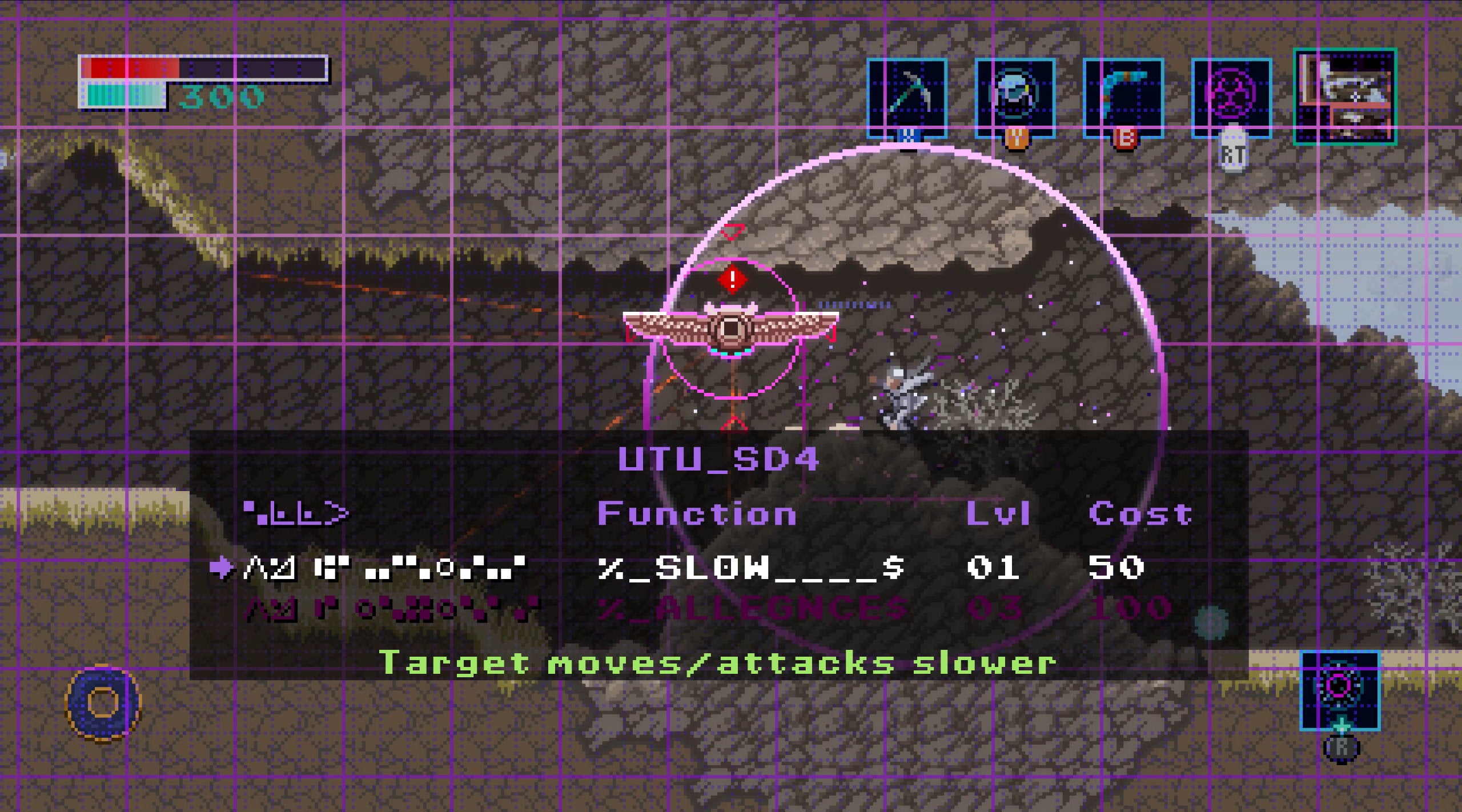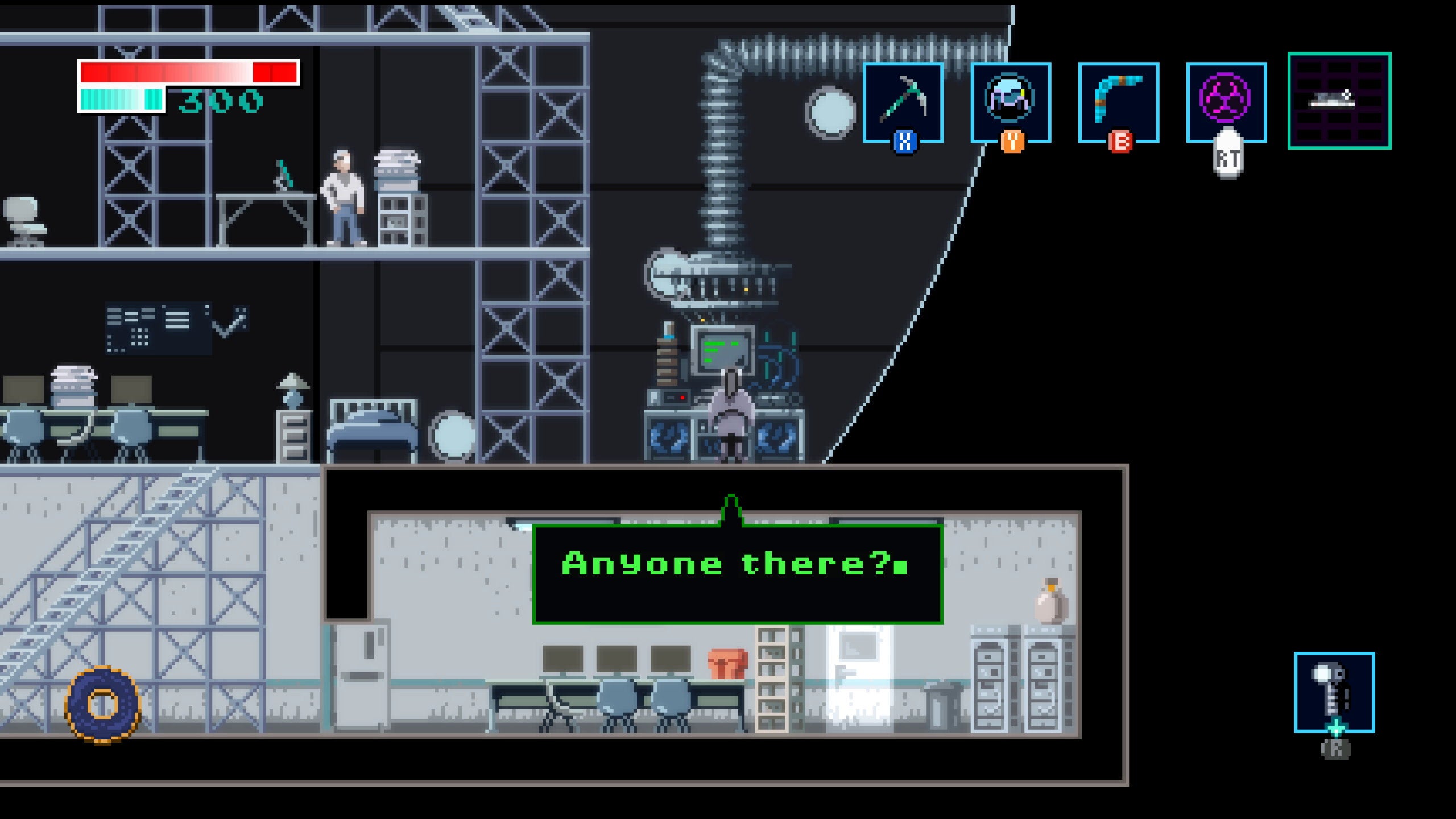Axiom Verge 2, a semi-sequel that’s set in the same universe as Axiom Verge 1 but can be played standalone without any knowledge of what went down beforehand, is a more sedate affair than its predecessor, but Happ’s fascination with portals, overlapping worlds and seeing beyond the veil has only grown stronger in the intervening six years. What it lacks in finger-tapping firepower, it more than makes up for with clever puzzles, a more meaningful skillset, and a very, very neat grappling hook. The grappling hook is arguably the secret star of Axiom Verge 2 - or more precisely, it’s the robot drone it’s attached to. Much like in Axiom Verge 1, new protagonist Indra acquires the ability to launch a small, remote metallic pal pretty early on in the game, allowing you to crawl through small passageways and reach new areas that are inaccessible to you as a human. So far, so Samus’ morph ball. Eventually, though (for reasons I won’t spoil here), this little drone becomes the most important bit of kit in Indra’s hastily put together toolbag, giving you new satisfying freedoms in the way you move through the world, and how you engage with it. Whereas its predecessor threw more guns at you than you knew what to do with, Axiom Verge 2 shows a much keener sense of focus in the way it doles out its (still plentiful) supply of upgrades, giving you the time and space to really invest in your equipment instead of instantly discarding it for a newer, shinier trinket. The same can be said of Indra herself. While her default ice pick can be swapped out for a handful of more powerful weapons over the course of the game (provided you seek them out), most of her upgrades revolve around her ability to traverse her new surroundings. As a scientist, Indra’s physical abilities are very much lacking at the start of the game, but dotted around this futuristic yet ancient, Assyrian-infused world are special urns with AI spirits known as Arms inside them, a kind of technological take on djinn that grant Indra special powers. As the game progresses, she becomes a lot more capable. She starts small with things like being able to pull herself up over ledges and cling to sheer cliff faces, but eventually she goes full sci-fi, gaining the ability to disintegrate her body in a kind of explosive slam attack to break down walls, as well as a special bracelet that can reveal new breach portals to other worlds that aren’t visible to the human eye apart from a small, telltale glitch in the environment. By the end, Indra becomes a master of her environment, and it makes for a much more satisfying learning curve than anything I remember from Axiom Verge 1. In fairness, some players may end up wondering what it’s all for. As previously stated, while Axiom Verge 2 does have some striking boss fights, you don’t actually need to engage with them at all to finish the game. Instead of hoarding crucial upgrades, your reward is simply more skill point canisters that Indra can guzzle down to improve her or her drone’s attack power, range and health. They’re worth taking on for the spectacle alone - one particularly standout boss sees you having to fight it with your tiny drone, making for an impressive David and Goliath moment when you finally take it down - but the meat of your ice pick slinging will be against much smaller robotic foes that can usually be taken down with a rush of button taps. There’s scope to get a bit more creative with your takedowns by hacking certain bot parts, causing canons to overheat, motors to slow or even see you as an ally, but I found myself using these powers less and less as the game went on. By the end, my drone had grown so powerful that it was often simply quicker and easier to mash attack and get things over and done with than try anything more sophisticated. There’s no real threat of failure, either, as dying simply sends you back to the last save station with all your progress still intact, giving you less impetus to approach combat smartly. This approach may prove divisive for diehards of the genre, but I can’t say this lack of bite really bothered me that much. Its clever world design and brilliantly conceived puzzles more than satisfied my completionist itch over its 10-odd hour run-time (in which I discovered 95% of the map and found 75% of its collectibles), and overall I had a good time with it. That said, for all the concessions Axiom Verge 2 makes toward newcomers in the combat department, it still has a surprising number of fussy old-school hangups when it comes to its mission objectives - which may prove equally divisive for Metroidvania fans who like a bit more hand holding in the vein of, say, Ori And The Blind Forest. While you always have a pulsing dot on your map that you’re working towards, I often found my progress hindered by not having the necessary power-up. No matter what angle I tried to approach it from, feeling things out around the edges of the map often left me stumped on where to go next. Instead, these all-important power-ups were often located in completely the opposite direction from my supposed goal, and many of them I seem to stumble upon by accident rather than by design. You do have a pulsing compass that lights up when you’re in close proximity to an urn or breach portal to help point you in the vague direction of nearby items, but it’s of little use when you’re halfway across the map looking for something specific. It rewards exploration, sure, but a few more pointers wouldn’t have gone amiss in my book. Again, though, once I’d grown acclimatised to what the game was asking of me, I did find myself warming to this approach over time, and learned to enjoy poking around new parts of the map I didn’t really have much business being in. There’s a surprising amount to discover here, and working out how to proceed, making mental notes of where to return to later and using my powers to open up new paths and possibilities (some of which were proper lightbulb moments) all scratched my favourite Metroidvania itches. Go in with this kind of mindset, and you’ll almost certainly have a cracking time with it. Axiom Verge 2 isn’t the most straightforward sequel, then, and some of its mechanical mutations are more successful than others. If you adored the guns and boss fights of the first game, then its sequel may be something of a disappointment. However, if you’re into the puzzles and exploration side of Metroidvanias, Axiom Verge 2 shows a level of sophistication in its design that I haven’t seen from this genre in quite some time, even if the end result can sometimes be a little obtuse. It’s familiar, yet different; the kind of game the first Axiom Verge might have been in an alternate timeline, which feels fitting given its obsession with portals and shifting realities. With the door left open for even further forays into this kaleidoscope of different dimensions, you can bet I’ll be back for more when Axiom Verge 3 rolls around.



